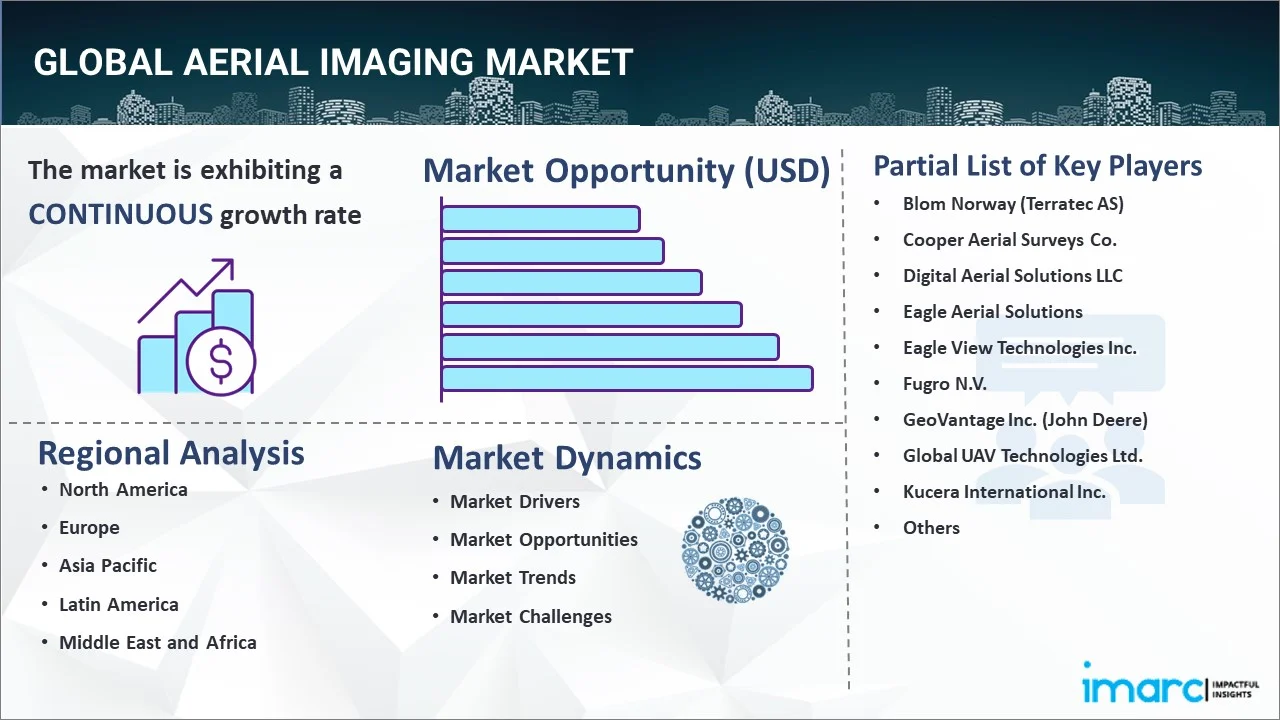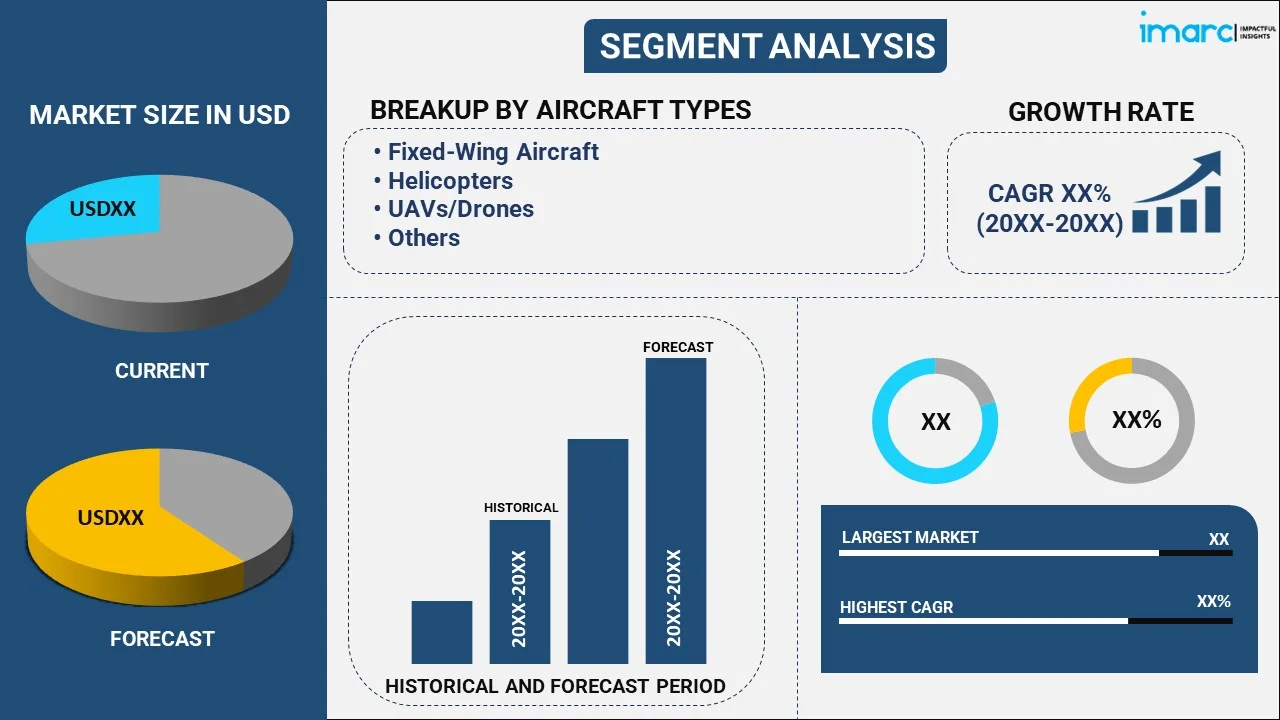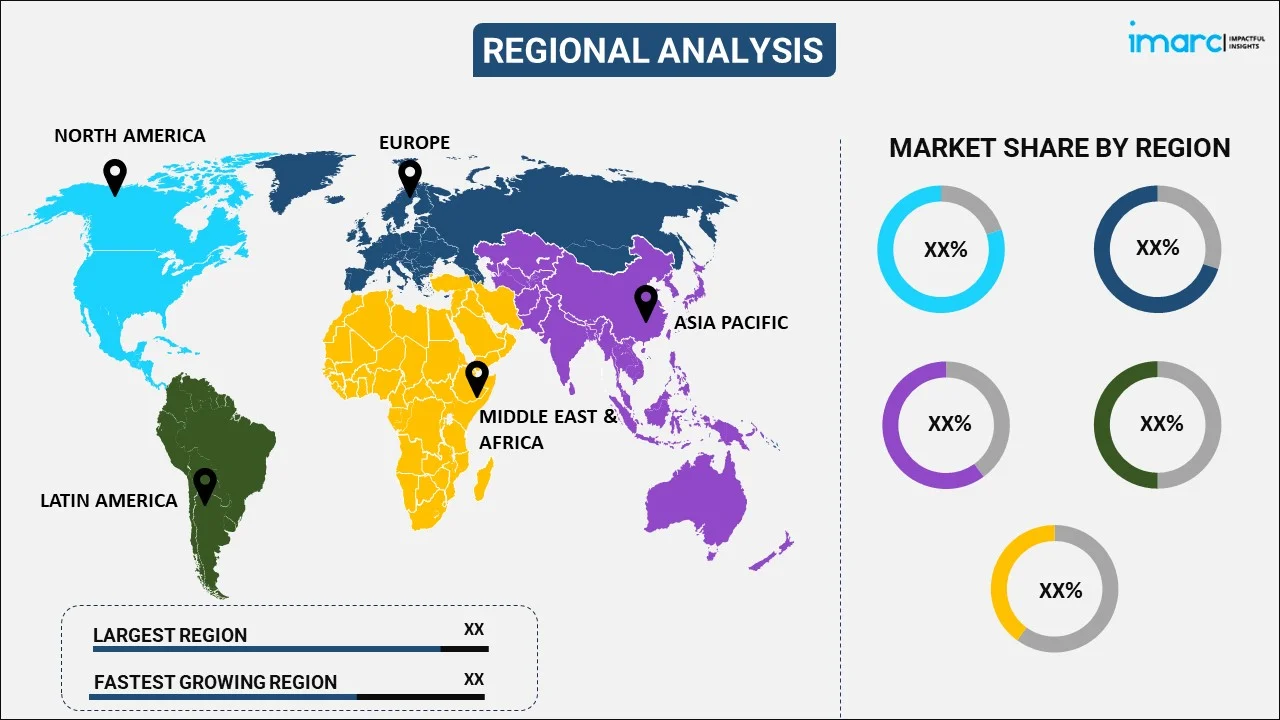
Aerial Imaging Market Report by Aircraft Type (Fixed-Wing Aircraft, Helicopters, UAVs/Drones, and Others), Camera Orientation (Vertical, Oblique), Application (Geospatial Mapping, Infrastructure Planning, Asset Inventory Management, Environmental Monitoring, National and Urban Mapping, Surveillance and Monitoring, Disaster Management, and Others), End Use Sector (Government, Energy, Defense, Agriculture and Forestry, Construction and Archaeology, Media and Entertainment, and Others), and Region 2025-2033
Market Overview 2025-2033:
The global aerial imaging market size reached USD 3.0 Billion in 2024. Looking forward, IMARC Group expects the market to reach USD 8.5 Billion by 2033, exhibiting a growth rate (CAGR) of 12.3% during 2025-2033. The growing construction of residential and commercial buildings, rising traveling and tourism activities, and increasing employment for examining archaeological sites represent some of the key factors driving the market.
|
Report Attribute
|
Key Statistics
|
|---|---|
|
Base Year
|
2024
|
|
Forecast Years
|
2025-2033
|
|
Historical Years
|
2019-2024
|
|
Market Size in 2024
|
USD 3.0 Billion |
|
Market Forecast in 2033
|
USD 8.5 Billion |
| Market Growth Rate 2025-2033 | 12.3% |
Technological Advancements in Unmanned Aerial Vehicle (UAV) and Drone Technology Augmenting Market Growth
The increasing demand for unmanned aerial vehicles (UAVs) and drones is experiencing rapid growth due to the rising employment of aerial imaging systems to ensure safety measures in various public places. Aerial imaging is also used for preventing terrorist activities around borders and ports and maintaining the safety of a nation. There is currently a rise in the demand for aerial imaging systems in the agricultural sector for crop monitoring and various other purposes. In addition, UAVs and drones are extremely effective for filming and photography as they enable individuals to take wide-angle shots of various locations and scenes. Moreover, the rising integration of various advanced features, such as voice assistance, internet connectivity, and geo-tagging, is bolstering the growth of the aerial imaging market.

Competitive analysis such as market structure, market share by key players, player positioning, top winning strategies, competitive dashboard, and company evaluation quadrant has been covered in the report. Also, detailed profiles of all major companies have been provided. The structure of the aerial imaging market is fragmented, with a large number of regional and local vendors operating independently. The volume of new entrants is high due to the requirements of low initial investments and constant product innovations. In addition, the product differentiation rate of the industry is low and key players are competing on the basis of the quality of services and pricing offered to the customers.
What is Aerial Imaging?
Aerial imaging refers to the process of capturing photographs of the ground via a flying object, such as a helicopter, fixed-wing aircraft, balloon, parachute, rocket, and unmanned aerial vehicles (UAVs). It comprises comprehensive imaging systems, which are equipped with light detection and ranging (LIDAR) systems, 360-degree vision cameras, and geographic systems to navigate locations. It is commonly used to collect insights about geospatial mapping, infrastructure planning, disaster management, ground surveillance, and environmental monitoring. Aerial imaging is often used in the agricultural industry to accurately monitor the current situation of soil, examine the health of crops, and inspect the occurrence of crop damage. It is also employed for taking wide-angle photographs and videos of properties that are on sale or facing legal issues. It offers a better understanding of construction lands and enables architects to make the right decisions regarding construction projects.
COVID-19 Impact:
The outbreak of the coronavirus caused a slight disturbance in the growth of the aerial imaging market due to the imposition of restrictions on roads and disruption of the normal supply of products. Besides this, the imposition of lockdowns impacted domestic supply chains, which closed production plants and other operations associated with the manufacturing process. However, there was an increase in the demand for aerial imaging systems for mapping vineyards, monitoring construction sites, and various other public places remotely by maintaining social distancing is propelling the growth of the market. In addition, governing agencies of various countries were utilizing video surveillance and broadcasting voice messages with drones to raise awareness among the masses. Besides this, aerial imaging became the most preferred way for businesses and individuals to gain an enhanced view of business operations remotely, which bolstered the growth of the market. Furthermore, the increasing utilization of drones by law enforcement departments to manage traffic and monitor the movements of vehicles on highways and roads supported the demand for aerial imaging during the pandemic.
Aerial Imaging Market Trends:
At present, the rising construction of various residential and commercial buildings around the world represents one of the key factors influencing the market positively. Besides this, the rising traveling and tourism activities across the globe to explore new places and enjoy beautiful scenic views are propelling the growth of the market. In addition, the growing utilization of aerial imaging in the construction industry to remotely perform research and land mapping is contributing to the growth of the market. Apart from this, the increasing employment of aerial imaging solutions for examining archaeological sites is supporting the growth of the market. Additionally, key market players are integrating various technologically advanced features, such as artificial intelligence (AI) and the internet of things (IoT), to enhance the functionality of aerial imaging systems. Moreover, the increasing adoption of aerial imaging for defense applications and conducting search operations in various inaccessible locations is bolstering the growth of the market.
Key Market Segmentation:
IMARC Group provides an analysis of the key trends in each sub-segment of the global aerial imaging market report, along with forecasts at the global, regional and country level from 2025-2033. Our report has categorized the market based on aircraft type, camera orientation, application and end use sector.
Aircraft Type Insights:

- Fixed-Wing Aircraft
- Helicopters
- UAVs/Drones
- Others
The report has provided a detailed breakup and analysis of the aerial imaging market based on the aircraft type. This includes fixed-wing aircraft, helicopters, UAVs/drones, and others. According to the report, UAVs/drones represented the largest segment as they are easier to fly for beginners, are equipped with cameras and have inbuilt navigation software. In addition, the rising employment of UAVs/drones to navigate difficult-to-reach regions is propelling the growth of the market.
Camera Orientation Insights:
- Vertical
- Oblique
- High Oblique
- Low Oblique
A detailed breakup and analysis of the aerial imaging market based on the camera orientation has also been provided in the report. This includes vertical and oblique (high oblique and low oblique). According to the report, oblique (high oblique and low oblique) accounted for the largest market share, as oblique pictures are effective for displaying landscape relief and scale. Apart from this, the increasing demand for oblique aerial photographs, as they can be taken from the most advantageous positions for better interpretation, is bolstering the growth of the respective segment.
Application Insights:
- Geospatial Mapping
- Infrastructure Planning
- Asset Inventory Management
- Environmental Monitoring
- National and Urban Mapping
- Surveillance and Monitoring
- Disaster Management
- Others
A detailed breakup and analysis of the aerial imaging market based on the application has also been provided in the report. This includes geospatial mapping, infrastructure planning, asset inventory management, environmental monitoring, national and urban mapping, surveillance and monitoring, disaster management, and others.
End Use Sector Insights:
- Government
- Energy
- Defense
- Agriculture and Forestry
- Construction and Archaeology
- Media and Entertainment
- Others
A detailed breakup and analysis of the aerial imaging market based on the end use sector has also been provided in the report. This includes government, energy, defense, agriculture and forestry, construction and archaeology, media and entertainment, and others. According to the report, agriculture and forestry accounted for the largest market share as it enables farmers to monitor extensive stretches of land. In addition, the increasing adoption of aerial imaging systems for crop health examination and estimation of soil productivity is supporting the growth of the market.
Regional Insights:

- North America
- United States
- Canada
- Asia Pacific
- China
- Japan
- India
- South Korea
- Australia
- Indonesia
- Others
- Europe
- Germany
- France
- United Kingdom
- Italy
- Spain
- Russia
- Others
- Latin America
- Brazil
- Mexico
- Others
- Middle East and Africa
The report has also provided a comprehensive analysis of all the major regional markets, which include North America (the United States and Canada); Asia Pacific (China, Japan, India, South Korea, Australia, Indonesia, and others); Europe (Germany, France, the United Kingdom, Italy, Spain, Russia, and others); Latin America (Brazil, Mexico, and others); and the Middle East and Africa. According to the report, North America (the United States and Canada) was the largest market for aerial imaging. Some of the factors driving the North America aerial imaging market included the growing investment in maintaining border security, various technological advancements in personal aerial mapping systems (PAMS) and increasing availability of low-cost drones. In addition, the rising application of aerial imaging in the real estate, hospitality, and agricultural sectors is propelling the growth of the market.
Competitive Landscape:
The report has also provided a comprehensive analysis of the competitive landscape in the global aerial imaging market. Some of the companies covered in the report include:
- Blom Norway (Terratec AS)
- Cooper Aerial Surveys Co.
- Digital Aerial Solutions LLC
- Eagle Aerial Solutions
- Eagle View Technologies Inc.
- Fugro N.V.
- GeoVantage Inc. (John Deere)
- Global UAV Technologies Ltd.
- Kucera International Inc.
- Landiscor Real Estate Mapping
Please note that this only represents a partial list of companies, and the complete list has been provided in the report.
Report Coverage:
| Report Features | Details |
|---|---|
| Base Year of the Analysis | 2024 |
| Historical Period | 2019-2024 |
| Forecast Period | 2025-2033 |
| Units | Billion USD |
| Segment Coverage | Aircraft Type, Camera Orientation, Application, End Use Sector, Region |
| Region Covered | Asia Pacific, Europe, North America, Latin America, Middle East and Africa |
| Countries Covered | United States, Canada, Germany, France, United Kingdom, Italy, Spain, Russia, China, Japan, India, South Korea, Australia, Indonesia, Brazil, Mexico |
| Companies Covered | Blom Norway (Terratec AS), Cooper Aerial Surveys Co., Digital Aerial Solutions LLC, Eagle Aerial Solutions, Eagle View Technologies Inc., Fugro N.V., GeoVantage Inc. (John Deere), Global UAV Technologies Ltd., Kucera International Inc. and Landiscor Real Estate Mapping |
| Customization Scope | 10% Free Customization |
| Post-Sale Analyst Support | 10-12 Weeks |
| Delivery Format | PDF and Excel through Email (We can also provide the editable version of the report in PPT/Word format on special request) |
Key Benefits for Stakeholders:
- IMARC’s report offers a comprehensive quantitative analysis of various market segments, historical and current market trends, market forecasts, and dynamics of the aerial imaging market from 2019-2033.
- The research study provides the latest information on the market drivers, challenges, and opportunities in the global aerial imaging market.
- The study maps the leading, as well as the fastest-growing, regional markets. It further enables stakeholders to identify the key country-level markets within each region.
- Porter's five forces analysis assist stakeholders in assessing the impact of new entrants, competitive rivalry, supplier power, buyer power, and the threat of substitution. It helps stakeholders to analyze the level of competition within the aerial imaging industry and its attractiveness.
- Competitive landscape allows stakeholders to understand their competitive environment and provides an insight into the current positions of key players in the market.
Key Questions Answered in This Report
The global aerial imaging market was valued at USD 3.0 Billion in 2024.
We expect the global aerial imaging market to exhibit a CAGR of 12.3% during 2025-2033.
The growing focus towards urban settlements and route designing, along with the increasing application of aerial imaging to aid in obtaining spatial information regarding land cover, vegetation areas, soil maps, etc., is primarily driving the global aerial imaging market.
The sudden outbreak of the COVID-19 pandemic has led to the rising demand for aerial imaging systems, such as UAVs/drones, for managing remote monitoring and mapping areas to set up isolation centers, COVID-19 test centers, remote vaccination camps, etc.
Based on the aircraft type, the global aerial imaging market can be segmented into fixed-wing aircraft, helicopters, UAVs/drones, and others. Among these, UAVs/drones hold the majority of the total market share.
Based on the camera orientation, the global aerial imaging market has been divided into vertical and oblique. Currently, oblique exhibits a clear dominance in the market.
Based on the end use sector, the global aerial imaging market can be categorized into government, energy, defense, agriculture and forestry, construction and archaeology, media and entertainment, and others. Among these, the agriculture and forestry sector accounts for the largest market share.
On a regional level, the market has been classified into North America, Asia-Pacific, Europe, Latin America, and Middle East and Africa, where North America currently dominates the global market.
Some of the major players in the global aerial imaging market include Blom Norway (Terratec AS), Cooper Aerial Surveys Co., Digital Aerial Solutions LLC, Eagle Aerial Solutions, Eagle View Technologies Inc., Fugro N.V., GeoVantage Inc. (John Deere), Global UAV Technologies Ltd., Kucera International Inc., and Landiscor Real Estate Mapping.
Need more help?
- Speak to our experienced analysts for insights on the current market scenarios.
- Include additional segments and countries to customize the report as per your requirement.
- Gain an unparalleled competitive advantage in your domain by understanding how to utilize the report and positively impacting your operations and revenue.
- For further assistance, please connect with our analysts.
 Inquire Before Buying
Inquire Before Buying
 Speak to an Analyst
Speak to an Analyst
 Request Brochure
Request Brochure
 Request Customization
Request Customization




.webp)




.webp)












